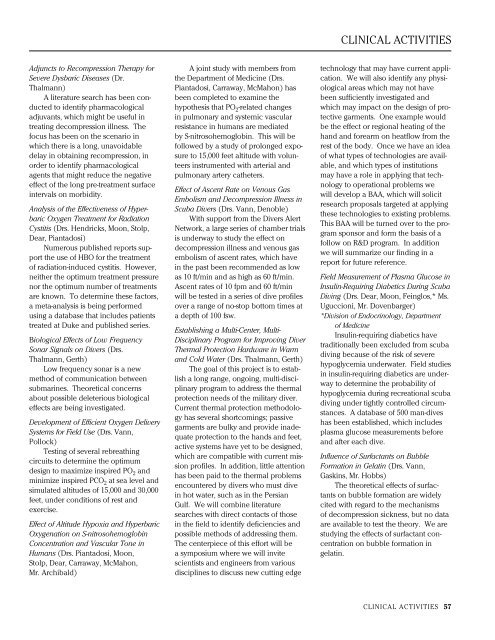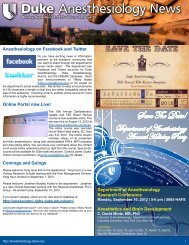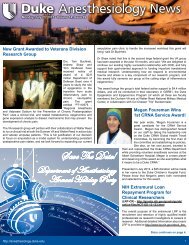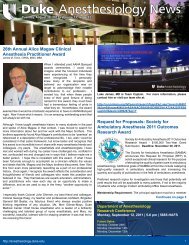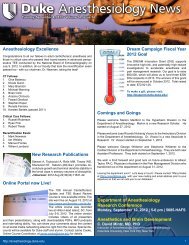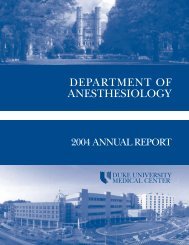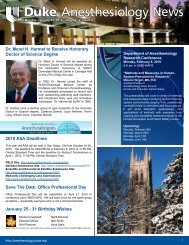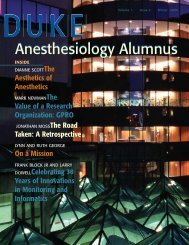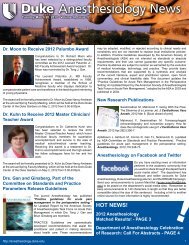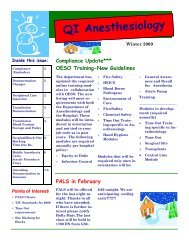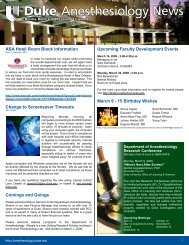DEPARTMENT OF ANESTHESIOLOGY ANNUAL REPORT
DEPARTMENT OF ANESTHESIOLOGY ANNUAL REPORT
DEPARTMENT OF ANESTHESIOLOGY ANNUAL REPORT
Create successful ePaper yourself
Turn your PDF publications into a flip-book with our unique Google optimized e-Paper software.
Adjuncts to Recompression Therapy for<br />
Severe Dysbaric Diseases (Dr.<br />
Thalmann)<br />
A literature search has been conducted<br />
to identify pharmacological<br />
adjuvants, which might be useful in<br />
treating decompression illness. The<br />
focus has been on the scenario in<br />
which there is a long, unavoidable<br />
delay in obtaining recompression, in<br />
order to identify pharmacological<br />
agents that might reduce the negative<br />
effect of the long pre-treatment surface<br />
intervals on morbidity.<br />
Analysis of the Effectiveness of Hyperbaric<br />
Oxygen Treatment for Radiation<br />
Cystitis (Drs. Hendricks, Moon, Stolp,<br />
Dear, Piantadosi)<br />
Numerous published reports support<br />
the use of HBO for the treatment<br />
of radiation-induced cystitis. However,<br />
neither the optimum treatment pressure<br />
nor the optimum number of treatments<br />
are known. To determine these factors,<br />
a meta-analysis is being performed<br />
using a database that includes patients<br />
treated at Duke and published series.<br />
Biological Effects of Low Frequency<br />
Sonar Signals on Divers (Drs.<br />
Thalmann, Gerth)<br />
Low frequency sonar is a new<br />
method of communication between<br />
submarines. Theoretical concerns<br />
about possible deleterious biological<br />
effects are being investigated.<br />
Development of Efficient Oxygen Delivery<br />
Systems for Field Use (Drs. Vann,<br />
Pollock)<br />
Testing of several rebreathing<br />
circuits to determine the optimum<br />
design to maximize inspired PO 2 and<br />
minimize inspired PCO 2 at sea level and<br />
simulated altitudes of 15,000 and 30,000<br />
feet, under conditions of rest and<br />
exercise.<br />
Effect of Altitude Hypoxia and Hyperbaric<br />
Oxygenation on S-nitrosohemoglobin<br />
Concentration and Vascular Tone in<br />
Humans (Drs. Piantadosi, Moon,<br />
Stolp, Dear, Carraway, McMahon,<br />
Mr. Archibald)<br />
A joint study with members from<br />
the Department of Medicine (Drs.<br />
Piantadosi, Carraway, McMahon) has<br />
been completed to examine the<br />
hypothesis that PO 2-related changes<br />
in pulmonary and systemic vascular<br />
resistance in humans are mediated<br />
by S-nitrosohemoglobin. This will be<br />
followed by a study of prolonged exposure<br />
to 15,000 feet altitude with volunteers<br />
instrumented with arterial and<br />
pulmonary artery catheters.<br />
Effect of Ascent Rate on Venous Gas<br />
Embolism and Decompression Illness in<br />
Scuba Divers (Drs. Vann, Denoble)<br />
With support from the Divers Alert<br />
Network, a large series of chamber trials<br />
is underway to study the effect on<br />
decompression illness and venous gas<br />
embolism of ascent rates, which have<br />
in the past been recommended as low<br />
as 10 ft/min and as high as 60 ft/min.<br />
Ascent rates of 10 fpm and 60 ft/min<br />
will be tested in a series of dive profiles<br />
over a range of no-stop bottom times at<br />
a depth of 100 fsw.<br />
Establishing a Multi-Center, Multi-<br />
Disciplinary Program for Improving Diver<br />
Thermal Protection Hardware in Warm<br />
and Cold Water (Drs. Thalmann, Gerth)<br />
The goal of this project is to establish<br />
a long range, ongoing, multi-disciplinary<br />
program to address the thermal<br />
protection needs of the military diver.<br />
Current thermal protection methodology<br />
has several shortcomings; passive<br />
garments are bulky and provide inadequate<br />
protection to the hands and feet,<br />
active systems have yet to be designed,<br />
which are compatible with current mission<br />
profiles. In addition, little attention<br />
has been paid to the thermal problems<br />
encountered by divers who must dive<br />
in hot water, such as in the Persian<br />
Gulf. We will combine literature<br />
searches with direct contacts of those<br />
in the field to identify deficiencies and<br />
possible methods of addressing them.<br />
The centerpiece of this effort will be<br />
a symposium where we will invite<br />
scientists and engineers from various<br />
disciplines to discuss new cutting edge<br />
CLINICAL ACTIVITIES<br />
technology that may have current application.<br />
We will also identify any physiological<br />
areas which may not have<br />
been sufficiently investigated and<br />
which may impact on the design of protective<br />
garments. One example would<br />
be the effect or regional heating of the<br />
hand and forearm on heatflow from the<br />
rest of the body. Once we have an idea<br />
of what types of technologies are available,<br />
and which types of institutions<br />
may have a role in applying that technology<br />
to operational problems we<br />
will develop a BAA, which will solicit<br />
research proposals targeted at applying<br />
these technologies to existing problems.<br />
This BAA will be turned over to the program<br />
sponsor and form the basis of a<br />
follow on R&D program. In addition<br />
we will summarize our finding in a<br />
report for future reference.<br />
Field Measurement of Plasma Glucose in<br />
Insulin-Requiring Diabetics During Scuba<br />
Diving (Drs. Dear, Moon, Feinglos,* Ms.<br />
Uguccioni, Mr. Dovenbarger)<br />
*Division of Endocrinology, Department<br />
of Medicine<br />
Insulin-requiring diabetics have<br />
traditionally been excluded from scuba<br />
diving because of the risk of severe<br />
hypoglycemia underwater. Field studies<br />
in insulin-requiring diabetics are underway<br />
to determine the probability of<br />
hypoglycemia during recreational scuba<br />
diving under tightly controlled circumstances.<br />
A database of 500 man-dives<br />
has been established, which includes<br />
plasma glucose measurements before<br />
and after each dive.<br />
Influence of Surfactants on Bubble<br />
Formation in Gelatin (Drs. Vann,<br />
Gaskins, Mr. Hobbs)<br />
The theoretical effects of surfactants<br />
on bubble formation are widely<br />
cited with regard to the mechanisms<br />
of decompression sickness, but no data<br />
are available to test the theory. We are<br />
studying the effects of surfactant concentration<br />
on bubble formation in<br />
gelatin.<br />
CLINICAL ACTIVITIES 57


